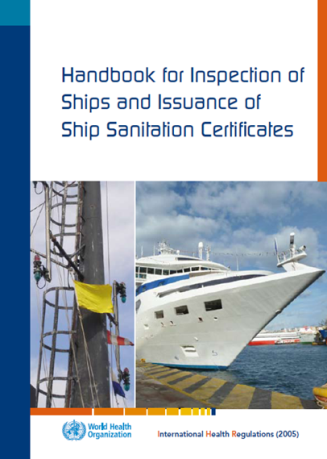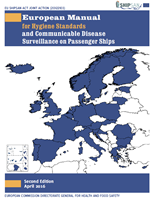Inspections
Responsible partner: University of Thessaly, Larissa, Greece
Τhe aim of inspection activities is to facilitate the European Union Member States (EUMS) to implement best practice for coordinating and executing hygiene inspections on conveyances, in order to prevent cross border disease spread and improve compliance with European legislation standards.
A common inspection schedule for passenger ships based on target factor (giving priorities to ferries and inland navigation vessels, considering historical inspection results) at an EU level is composed annually by all participating authorities in the EU ports. Inspection findings are shared among authorities through the European information system.
To improve and motivate compliance with the European inspection standards, passenger ships receiving grade A in the inspection will be published in the web portal of the joint action, together with the list of all ships inspected, which will be updated each time a new inspection is conducted.
Best practice for inspection auditing and for inspecting conveyances for vectors will be identified. Auditing guidelines for hygiene inspections on ships will be developed. A representative number of inspections will be audited by external observers to test how the best practice for inspection auditing and for inspecting conveyances are applied in the participating countries. Moreover, guidelines will be composed for focused inspections of conveyances in case of outbreaks.
This Joint Action operates an information system with the following components:
a) the European Ship Sanitation Inspection Database Information System for issuing/recording IHR SSCs based on WHO Handbook (Access)
b) a European database for storing and sharing data from positive Maritime Declarations of Health submitted to the NSW according to Directive 2010/65/EU (Access)
c) Communication Network platform, allowing ship-to-port/port to National/port-to-port information sharing on response to public health events (Access)
d) an expert communication platform for air, maritime and ground crossing transport health threats (Access)
e) a database with the inspection results according to the European Manual for hygiene standards and communicable disease surveillance on passenger ships (Access)
f) a training platform for PoE hosting e-learning synchronous and asynchronous courses (Access)
Under work package 7, the Joint Action will produce:
- Best practice for inspection auditing and for inspecting conveyances for vectors, and guidelines for focused inspections of conveyances in case of outbreaks.
- Inspection auditing guidelines and SOPs based on best practice for inspections of vectors on conveyances.
- Guidelines for focused inspections of conveyances in case of outbreaks.
Inspections for issuing Ship Sanitation Certificates
EU HEALTHY GATEWAYS supports the implementation of the WHO handbook for inspection of ships and issuance of Ship Sanitation Certificates (Access).

EU HEALTHY GATEWAYS operates the Ship Sanitation Inspection Database Information System for issuing/recording IHR Ship Sanitation Certificates based on the WHO handbook (Access).
Functions: Recording and issuing SSCs based on WHO handbook, generation and print of official documents related with the inspections (i.e. SSC and the Evidence Report).
This information system can be used by officers working at ports authorised to issue Ship Sanitation Certificates in Europe under the International Health Regulations.
Training is conducted both face–to-face and e-learning, by using the WHO learning programme and the WHO e-learning platform (http://extranet.who.int/ihr/training)
European scheme for inspections of passenger ships
Considering the particular conditions on passenger ships, EU HEALTHY GATEWAYS implements a programme for passenger ship inspections and audits in European countries applying the EU legal framework.
Common inspection procedures and competency framework in EU MS
In the framework of the EU SHIPSAN ACT Joint Action, Inspection rules/guidelines were produced and agreed by all involved parties describing roles, responsibilities, rights, obligations, confidentiality of inspection results, dissemination of statistical data, use of results and dispute resolution.
The participating EU MS agreed to:
- follow common standardised inspection procedures by using the European Manual for Hygiene Standards and Communicable Disease Surveillance for conducting inspections on board passenger ships,
- use Inspection Outlines based on the MAESTRO concept assisting inspectors in collecting evidence in a systematic manner for each area/process.
Competency framework
- It sets criteria to be fulfilled by inspectors in order to conduct inspections according to the European Manual.
Criteria
- The competent authority has agreed to participate in the inspections of passenger ships scheduled at a European level and conducted according to the European Manual.
- The inspector works in a competent authority of an EUMS that is mandated by this EUMS to conduct hygiene inspections on passenger ships.
- The inspector has undertaken training (e-learning, face-to-face and on the job) for the European Manual based on the training material of SHIPSAN and fulfills the criteria included in the competency framework.
Inspection standards and tools

Inspections for passenger ships are conducted in accordance with the standards included in the European Manual for Hygiene Standards and Communicable Disease Surveillance on passenger ships (Access).
EU HEALTHY GATEWAYS operates the SHIPSAN ACT Information System for recording inspections based on the European Manual for Hygiene Standards and Communicable Disease Surveillance on passenger ships (Access).
Short notice routine inspections (since 2015 - to date):
-
In the framework of the EU SHIPSAN ACT Joint Action, since 2015, short notice (48hrs) inspections are conducted on passenger ships sailing in EU on an international voyage, according to the 2nd Edition of the European Manual for Hygiene Standards and Communicable Disease Surveillance. This continues under the EU HEALTHY GATEWAYS Joint Action.
-
Inspections in the EU are scheduled to be conducted by trained port health officers in accordance with a pre-agreed annual inspection programme issued at European level by Ministries of Health of 19 EUMS.
-
The EU HEALTHY GATEWAYS Joint Action is funded by the European Union’s Health Programme (2014-2020). The General Assembly and the Coordination team of a previous EU-funded Joint Action with acronym SHIPSAN ACT - Agreement Number 2012 2103 (2013-2016), decided that the ships that are going to be inspected will receive a 48-hour notice. According to the Grant Agreement (801493) of the EU HEALTHY GATEWAYS Joint Action, these activities continue to take place under this new joint action, by adding the component of inspection audits. The University of Thessaly is the leader of the work package number 7, titled “Maritime transport” and is responsible for supporting the scheduling of inspections in 2018-2021.
-
In 2018, a total of 19 ports from 11 countries (Spain, Ireland, Lithuania, Cyprus, Greece, Slovakia, Estonia, Slovenia, Croatia, Belgium and The Netherlands) participated in the inspection programme of passengers ships according to the European Manual. In total, 27 cruise ship companies, three ferry companies and four river companies participated after a short 48 hour notification warning them about the inspection. Inspections were conducted by 29 inspectors fulfilling the SHIPSAN criteria, and 20 fulfilling SHIPSAN criteria partially. From June until December 2018, 47 full inspections were conducted on board 36 cruise ships, 4 ferries and 7 river ships.
Table 1: Short notice inspections conducted in 2018 on passenger ships according to the European Manual
|
Short Notice Inspections
|
|
Inspections
|
47
|
|
Ports
|
19
|
|
Inspectors/inspectors in training
|
29/20
|
|
Countries
|
11
|
|
Cruise ships (seagoing – inland)
|
43
|
|
Ferry boats
|
4
|
|
Corrective Action Statements
|
47
|
Publication of inspection grading results
The rules for publication of inspection results have been described in the consortium agreement of the EU HEALTHY GATEWAYS joint action as follows: “In the framework of the Project under work package 7, inspections on passenger ships will be conducted according to the European Manual for Hygiene Standards and Communicable Disease Surveillance on Passenger Ships by inspectors working at the competent authorities of EU Member States, following the procedures described in the Manual and in Deliverables 1 and 6 of the EU SHIPSAN ACT Joint Action. A common inspection schedule, based on target factors (giving priorities to ferries and inland navigation vessels, considering historical inspection results) at an EU level, will be composed annually and agreed to by all participating authorities to avoid duplicate inspections in the EU ports. Inspections will be conducted according to this annual schedule and issued by the competent authorities conducting the inspections in collaboration with the UTH-EL. The inspection results will be graded (A, B, C, D). When a ship obtains a D grade, it will be considered unsatisfactory and a follow-up inspection will be conducted. Inspection reports and the inspection grades will be reviewed by UTH-EL before finalization, as described in standard operating procedures of Deliverables 1 and 6 of the EU SHIPSAN ACT Joint Action. In 2018 the grading system of inspections will be pilot tested. A working group for pilot testing the grading system will be established. The grading system will be finalised after completion of the 2018 inspections. Inspection findings will be shared among authorities through the information system. The competent authorities authorise UTH-EL to publish the list of all ships inspected, highlighting those with “A” inspection grades, in the EU HEALTHY GATEWAYS web portal. The list will be updated weekly. Publication of inspection results will start in 2019.
The inspection reports will not be published, but shared if necessary with other interested parties by the competent authorities that conducted the inspections, according to their national rules and the Regulations (EU) 2016/679, (EC) No 178/2002, 852/2004 and 882/2004”.
The draft grading system was pilot-tested in 28 ships from September to December 2018.
Audits
In 2018, 12 audits by one expert were conducted in the following ports of EU MS (Tallinn, Koper, Zeebrugge, Kavala, Split, Limassol, Heraklion, Piraeus, Vigo, Amsterdam, Valencia).
The objectives of the audits are:
- To identify areas for improving the inspection programme.
- To measure the progress made in achieving standarisation of inspections.
- To identify any training needs on the inspection procedures, the techniques, the technical knowledge on areas of the European manual and the use of SIS.
- To identify any training needs based on the inspector competencies detailed in the European Manual, Part B – Annex 1 and 2.
- To provide training as part of the audit process, as appropriate.
- To support the inspection team to apply the inspection grading system.
Pilot testing of the scoring system in 2018
In the framework of work package 7 of the EU HEALTHY GATEWAYS Joint Action and using the deliverables produced under the EU SHIPSAN ACT Joint Action, a grading system has been developed for inspections of passenger ships conducted according to the European Manual. The pilot testing of the grading system will be applied to the inspections conducted from September to December 2018. A working group for pilot testing the grading system has been established. The pilot testing of the grading system will be applied to the inspections conducted from September to December 2018. The calculation and resulting inspection grading process will happen only after the inspection report is finalized in SIS. The inspection results will be graded (A, B, C, D). The letter grade will correspond to the sum of the scores of the items cited in the inspection report, and that a decision has been taken by the inspection team that points should be deducted. When a ship obtains a D grade, it will be considered unsatisfactory and a follow-up inspection will be conducted.
Inspection reports and the inspection grades will be reviewed by UTH-EL before finalization. The competent authorities authorise UTH-EL to publish the list of all ships inspected, highlighting those with “A” inspection grades, in the EU HEALTHY GATEWAYS web portal. The list will be updated weekly. Publication of inspection results will start in 2019.
Training
Training is conducted both face-to-face and e-learning by using the European Manual for Hygiene Standards and Communicable Disease Surveillance on passenger ships, and the SHIPSAN ACT e-learning platform http://elearning.shipsan.eu/
Links